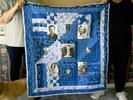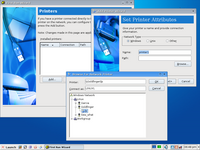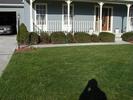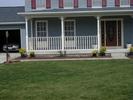
 |
HomeGraffitiAboutSitemapVisualDevWork
Email BrianGPG Key |
GRAFFITI -- April 12, 2004 thru April 18, 2004>> Link to the Current Week <<Last Week << Mon Tues Wed Thu Fri Sat Sun >> Next Week Welcome to Orb Graffiti, a place for me to write daily about life and computers. Contrary to popular belief, the two are not interchangeable. About eMail - I publish email sometimes. If you send me an email and you want privacy or anonymity, please say so clearly at the beginning of your message. |
 
|
MONDAY
Tues
Wed
Thu
Fri
Sat
Sun
April 12, 2004
 0712 - Good morning. Here's another few pictures from the last few days. On Friday, the trio went to see the Udvar-Hazy Center, the new facility of Air and Space (Marcia and I went there with Pete back in December). Karen got some nice snaps of the planes - I've got some pruning and cropping to do there first, so here's some shots from after that time. On the way home, Karen took a shot out the passenger side of the Santa Fe of the street leading to our house. It's not just the cherry trees that are blooming ... everything that can put out pollen is going hell-bent-for-leather to attack my sinuses. But it sure is pretty.
0712 - Good morning. Here's another few pictures from the last few days. On Friday, the trio went to see the Udvar-Hazy Center, the new facility of Air and Space (Marcia and I went there with Pete back in December). Karen got some nice snaps of the planes - I've got some pruning and cropping to do there first, so here's some shots from after that time. On the way home, Karen took a shot out the passenger side of the Santa Fe of the street leading to our house. It's not just the cherry trees that are blooming ... everything that can put out pollen is going hell-bent-for-leather to attack my sinuses. But it sure is pretty.
 On the evening of the day that our guests arrived, Marcia made a present of the quilt shown at left to Karen. These are old family photos, printed onto fabric then stitched into the quilt. It took Marcia a long time to piece all of those blocks, assemble and quilt it to arrive at the finished product. But Karen's reaction was worth every minute - she loves it.
On the evening of the day that our guests arrived, Marcia made a present of the quilt shown at left to Karen. These are old family photos, printed onto fabric then stitched into the quilt. It took Marcia a long time to piece all of those blocks, assemble and quilt it to arrive at the finished product. But Karen's reaction was worth every minute - she loves it.  [Click here to get the 2.8 MB full-resolution quilt picture] Of course, over the last few weeks, Lucy has started to realize her new responsibilities (assumed from the departed Sally) to accompany and help Marcia in every aspect of her sewing. This involves, among other activities, being directly under foot at all times, except when barking out the window at interlopers in her extended yard. [Note: An extended yard is that space which stretches to the limits of dog vision, hearing and smell ... a long bloody way, mate!] At right, Lucy is helping display the quilt to it's best advantage.
[Click here to get the 2.8 MB full-resolution quilt picture] Of course, over the last few weeks, Lucy has started to realize her new responsibilities (assumed from the departed Sally) to accompany and help Marcia in every aspect of her sewing. This involves, among other activities, being directly under foot at all times, except when barking out the window at interlopers in her extended yard. [Note: An extended yard is that space which stretches to the limits of dog vision, hearing and smell ... a long bloody way, mate!] At right, Lucy is helping display the quilt to it's best advantage.
 Yesterday, we stayed busy. Marcia and I did yardwork ... indoors. We filled all of our pots, got the bulbs set in their new homes, ready to adorn our deck in a few weeks, and carried all those full pots out of the garage to their spots on the front porch and back deck. Afterwards, it was important that Marcia and Lucy take a nap. Again, Lucy's taken her job seriously - under the blanket and napping with the mommy. When I left them, both were stretched out on the couch, but Lucy was on her tummy. When I came back down to wake them, Lucy was on her back, as shown at left here, only eyes closed. Of course, the waking up turned out to be only a halftime show - Both nappers wanted to be left to sleep some more, pretty please?
Yesterday, we stayed busy. Marcia and I did yardwork ... indoors. We filled all of our pots, got the bulbs set in their new homes, ready to adorn our deck in a few weeks, and carried all those full pots out of the garage to their spots on the front porch and back deck. Afterwards, it was important that Marcia and Lucy take a nap. Again, Lucy's taken her job seriously - under the blanket and napping with the mommy. When I left them, both were stretched out on the couch, but Lucy was on her tummy. When I came back down to wake them, Lucy was on her back, as shown at left here, only eyes closed. Of course, the waking up turned out to be only a halftime show - Both nappers wanted to be left to sleep some more, pretty please?
Now here's a little something I whipped up for you late yesterday afternoon and evening. Enjoy!
Here's my setup:
... All running on Goldfinger, the dual Athlon MP 1900+ workstation.
Let's see if this puppy flies ... why, yes it does, so far. After the Welcome splash screen, we come to the license acceptance, which has the following interesting key term:
...The End User may install the Software Product on unlimited home computers of his or hers for non-commercial user, and one commercial use computer.
That's pretty enlightened, with respect to wanting to make a business of Linux, neh? Now, I'll make two passes through the installer. First, minimum choices with the Express Install version. [I just took a time out to get ntpdate installed on another Xandros installation I'm mucking about with].
So far, there's been four clicks. Set Administrator (root) password, twice, name the machine and the fifth click. User account name, user full name, password twice and the sixth click. Click on Finish button, and it's all over but the shouting. Seven fields and Seven Clicks take me all the way to the end of the installation. Now that's a short run. Of course, there would have been more if I didn't have a DHCP server setup here, but overall, I'm impressed.
Now, let's break up this party and take the slow path through the installer, just to see how HARD it can be. The intro stuff is all the same, of course, until it's time to select the installation type, where the paths diverge.
Once Custom Install is selected, the next step is the choice of software packages to commit to the hard disk. There are four basic choices on this screen: Minimal, Standard, Complete and Custom. Complete has only Apache, an FTP server and an icon editor over the "Standard" set, and interestingly, Custom is smaller than Minimal. In the Software list box below the radio buttons, optional system components can be added or removed from the install set. No provision is made for a non-GUI or hyper-minimal setup (easily done with a standard Debian install). However, I think it's best to install a "Standard" desktop without modifications and see where that takes us.
In the Disk Configuration screen, the non-pertinent options are grey'd out. In this case, the installer sees the aborted pass through the Express Install as an existing Xandros install, so offering that option. Resizing a Windows partition is not available, and when viable,is only for FAT and FAT32 partitions. The website says that the Deluxe versions can handle resizing NTFS partitions, too.
Me, I don't resize partitions. I back up the data, blow away the old partition setup, create the new setup, and restore the data as appropriate. Works like a charm, and more reliable than a resize, with the added bonus of creating the backup needed before any such exercise, anyway.
Here's a gander at the Manage Disks and Partitions sub-screen and Assign dialog. There's not much to it that nearly any warm body can't handle. Additionally, there is one special option to allocating a partition: move /root and /home out of the way and wipe the rest of the partition. That's a sweet option and not one I've ever seen before.
However, I'll take the boring course, and just select the "Take over disk or partition" option from the main Disk Configuration screen. Let's see where that takes us.
There I'll choose the whole disk, and continue...
The summary just confirms what I've chosen to do, a nice touch. Note that at this point, nothing's been committed to disk yet. I can still press the reset button and walk away, without affecting the (possibly) pre-existing OS/data.
Next task to accomplish is Networking setup. I could allow the DHCP server to pick up the load, but it's my habit to use static IP addresses for anything that's likely to boot four or more times in my home network. Out of the 192.168.1.0/24 network, I have allocated .51 through .100 for use with VMware installed machines. The lowest free slot right now is .53, so that's what I assign. Once I save the static setup, I'll be allowed to add the gateway and DNS server specifications, both of which are on internal interfaces. That done, I'll continue to the next screen.
A short stint of administratriviata here: root password, computer name, and two options not available in the express install - strong passwords and private homes. Both of those default to off, I enable them and proceed.
In the Express install, there's only one user account created during installation. Here we can add one or many. In the screenshot above I've shown one of the error dialogs that pop up when an improper value is typed into an entry field. Of course, if I'd read the two sentences of instruction in the Add/Edit dialog, I'd be better off, eh? So I'll put in the right data, add that one user, and continue with the installation configuration.
This is the point of no return. All of the options set are summarized. The warning message is actually flashing RED, not to be missed (and a good thing, too). So I select Finish and ...
All of that would have taken me about 5 minutes in real time. It took quite a bit more, what with screen shots and writing up the accompanying text. At the end of the process (which took less than 15 minutes with this setup, YMMV), a dialog pops up to offer the option to Create a boot floppy, or Exit the completed installation. I'll choose the latter.
The initial bootscreen is a framebuffer splashscreen, the Xandros and logo fade in, then the menu appears at the top. I've already taken a quick stroll down Configure (Expert) lane, to install the VMWare tools and custom X server needed for this setup. Now I'll select the default option, which is what you'd do from the get-go: Xandros Desktop 2.0.
The men fades out while the logo sparkles. Oh, how cute. A few non-threatening notes appear in the upper left corner, not nearly as imposing as a full Linux boot scroll. And then there's the login screen. User name and password fields, in a field of Xandros blue horizontal pinstripe.
Nothing special about that, particularly. All available system users can be selected from the User name pulldown list. And of course, it's important to type your password correctly. That can be hard, at first, if you choose good passwords, and different ones for each account, neh? Yeah, it's hard. Oh, well.
The boot splash is a Xandros-customized version of the KDE startup, and I'll not bore you with that, nor with the First Run Wizard for customizing the desktop - there's nothing difficult or tricky in either ... at least until I got to the Printers page. This isn't the standard KDE setup, modified, after all.

Printers Wizard from FirstBoot
Above, I've selected Add... from the First Run Wizard - Printers screen. The Add Printer Wizard comes up, and offers me different choices depending on whether I've got Windows, Unix or Other selected. I can choose Windows, then browse the SMB network for printers. With nary a hitch, I add access to both my local laserjet available under Samba from Goldfinger and the Brother MFC-4800 hooked to Marcia's laptop, printing a test page from each as part of the process.
[Note: The MFC-4800 isn't directly supported by Linux as such. But the laser printer portion of the device happily prints if I tell any CUPS installation that the printer is an MFC-8300. It's just a little lie, really.]
The Unix selection permits connections to legacy lpr queues. Under the Other option, connections to CUPS servers and network-enabled printers are the order of the day. It all just works. Interestingly, CUPS servers that broadcast printer availability just appear, as magic, in the list of printers. That's what CUPS does for you. Properly configured, it rocks. And so does this printer setup wizard thingy. Well done, Xandros!!!
Following the Printer setup, the look and feel of the desktop can be set. There are a number of options. The default Xandros one is just fine - it's not identical to KDE, but it's close. Indeed, it's close enough to Windows behaviour not to throw the neophyte off the scent entirely, while different enough to let you know you're not working in Windows, and don't expect everything to work exactly the same way.
I would show you a screenshot here, but in the process of experimentation with this "feature" I selected and applied the XP look and feel. Guess what? The application locked up, then shut down. I can only imagine that it's some interplay between Xandros, the VMware setup, and the settings of that particular configuration item. The alternative is that some coder thought it would be a really good idea to emulate Windows functionality precisely, but I imagine that wouldn't *really* have gotten through the QC process. Part of me hopes the latter is the answer, but I know better, I've actually run through this four or five times, and this is the first trouble I've had (and also the first install on a VM).
Of course, the first apps to look at on a freshly installed system are those given pride of place on the desktop. There's not much to surprise the user at first glance. Trash, Home, a Guide, a Web Browser (Mozilla 1.6), and something called Xandros Networks. Not knowing any better, I'd guess that it's probably advertising cruft, but best to see first (no, I'm pretending I haven't read any of the docs, just like Joe User).
Wonderful! Xandros Neworks is the Package management tool for Xandros Desktop 2.0. From online updates to packages that can be removed or added (most free, some after registration, some with cost, like StarOffice 7, for example), Xandros Networks is a neat tool. The Application Updates page (shown) is not unfamiliar looking to anyone who's used the Update site in that other OS.
Updates can be done one at a time via the "Install now" links, or as a whole, by clicking on the ... um, undescribable, but for blue and square ... icon with the tool tip that reads "Install All Latest Updates...". Either will require administrative (root) access, and prompts for the appropriate password. When "Done" appears in the Updating System dialog window, I click on the Close button, and all is complete. Well, "all" as in all critical updates. There are still plenty of recommended updates and a few driver updates.
The interface of this tool hides most of the complexity of Debian package management from the user. There were only a couple of points in all my testing where prompts from the underlying Apt process made it to the dialog at the top level. In both cases, all I had to do was type "y" to continue. But then, I knew what I was doing. The confirmation was for the downloading of required dependency packages - that should also be automatic under this tool. That's the worst thing I can say about it, though. It doesn't hide enough. Heh, imagine me saying that!
The fit and finish of this Xandros distribution, based on Debian Gnu/Linux, is top-drawer. They have made the selection of the key bits of software that a person should use, from the KDE desktop and all of it's glitz and utilities, to OpenOffice 1.1 and Mozilla 1.6. Then there's the best part of all, the Xandros File Manager.
The Xandros File Manager is Konqueror's File Manager mode on the really good steroids. Of course browsing the local file system. But then there's Printers, Windows Network, NFS Network, CD Writer, CD-ROM and Floppy. Above, I'm showing the virtually instant access to a guest-accessible share on my local workstation's Samba setup. In order to work inside that share with system apps, I'd have to do the equivalent of "Map Network Drive", yes? That's what the link "Mount this share..." is, just below the name of the resource.
It all appears like pretty obvious stuff to me, but then, I've been doing computers for far too long. This is one of the best implementations of Windows/Linux interoperability I've ever seen.
Connecting to a more restricted resource pops a dialog that prompts for username, password and domain (workgroup). I type the right information to connect to Marcia's resources on Garcia, our local file and backup server. There I am.
The premise behind Xandros is that while OSS in general and Linux in particular are all about choice, and lots of it, your average user doesn't want choice, he wants to get the job done.
I know people who *KNOW* that some sites work better on IE than on Netscape, yet when a specific site fails for them with Netscape, they call me. The UAL site is broken, they say. Did you try it in Internet Explorer, I ask. Um... no. Since comfort is specified under these terms as "what I know", Xandros takes on the role of parent, making choices for the user, then making the experience of those choices as good as possible.
As I noted, Xandros is Debian-based. That means (theoretically) full access to the myriad (over 10,000) software packages that exist in the Debian archives. Fully installed (excepting the Apache and FTP servers plus dependencies), the Xandros Desktop system has 624 packages installed. A small fraction of the available total. And if it isn't in the Xandros repository, then it'll be a mite challenging for the newbie to install. You'd have to know how to modify your Apt sources list, and cope with the inevitable dependency problems, as a number of the packages that Xandros uses are custom-built for compliance with their packaging and user-experience requirements.
For example, in another installation, I went and fetched the ntpdate debian package from an official repository. In order to install it, I had to force it past a glibc dependency. But these are quibbles. By the time a user needs the full power of everything Linux and Debian have to offer, they've probably figured out what they need to do. And for someone who just wants to get the job done, Xandros offers a remarkably clean, consistent and powerful suite of packages, wrapped up with a good set of customized tools.
Xandros Desktop 2.0 Standard - Highly Recommended.
*** Disclaimer - I don't have any relationship with Xandros, nor was this a promotional copy - I bought it with my own dollars, just to test it for you and others that I might want to recommend it to. I just can't recommend (or not recommend) something I've not tried for myself.
Mon
TUESDAY
Wed
Thu
Fri
Sat
Sun
April 13, 2004
0655 - Good morning. I worked, I ate, I slept. Precious little else of import. There's some buzz in the air about something called Colinux. Let me know, will you? Have a great day!
Mon
Tues
WEDNESDAY
Thu
Fri
Sat
Sun
April 14, 2004
0626 - Good morning. Here I am again. Sorry for the brevity yesterday, and it's likely to be the same today, but then after giving Sunday afternoon and evening to the cause, I suppose that I can be excused. Besides, by mid-evening last night I was feeling rather icky and thought I had a fever (I didn't though, what's up with that?). That's better this morning, but who knows what's going on. I certainly slept restlessly and my eyes were mere slits filled with sand as I crawled into the shower a few minutes ago. I thought I should have one of those scanning LEDs, like the Centurions in Battlestar Galactica. Anyway, we've had out-of-state guests and a bunch of tourist experiences in the last week - I wouldn't be surprised by an out-of-state virus to match.
A surprisingly complete lack of feedback to the Xandros writeup from Monday. Yesterday we installed it on Larry's laptop (a Latitude of about 16 months), and Xandros picked up the wireless card, the WinModem (results on that later today, Larry was testing last night), the sound, and nvidia video (with the binary driver pre-present). Poof, just worked! I may install Xandros on real hardware on THIS desktop and see how it goes. I doubt it'll replace Gentoo as my normal working system, but keep tuned. I'll keep giving you reports about how this distro does for people who haven't had as much luck with Linux as they'd like in the past.
Book Meme: Grab the book nearest you, turn to page 23, find line 5. Write down what it says, along with this sentence, and post it in your journal.
"installation process. When you're just getting started with Python, you normally"
There are 74 links on Google to this meme, as of this writing. Thanks to MikeM for the heads up on that one, and for pointing out that MS released FIVE (5) Critical Update patches yesterday. I'll give it a day for early pioneers to take arrows in the back. If none of the patches are withdrawn by Thursday, I'll start updating client boxes.
Doc Searls just left the area, he'd been visiting because his daughter (search for Searls) teaches at UMBC and had a production going on at the Kennedy Center. I'd have offered a crash pad, but he has family here, neh? But when you're in town, Doc, you're welcome... Oh, yeah, and don't forget that Doc had one of my favorite humorous R&B Music stories of all time, in the context of John Lee Hooker's barber.
Okay. I'm back up in Gaithersburg today, the reason for the early start (is the long drive, yeah?) and I'd best be on my way. Have a great day!
Mon
Tues
Wed
THURSDAY
Fri
Sat
Sun
April 15, 2004
They're done and mailed. I've nothing else to say today.
Mon
Tues
Wed
Thu
FRIDAY
Sat
Sun
April 16, 2004
0659 - Good morning. A sunny day out, but still, time to go to work. And last night, rather than do anything fun, I was updating servers remotely at client sites (during non-working hours for them, don't you know). Today I'll be applying those new Microsoft patches to many more machines. Hope you're having fun, too. Have a great day!
Mon
Tues
Wed
Thu
Fri
SATURDAY
Sun
April 17, 2004
0743 - Good morning. A number of people (hey, Carl) have written. Don't be distressed that I haven't replied. Be distressed that I blew away my to-be-filed folder, that had the emails in it to be replied to. I understand that a lot of people have had problems with desktop Linux. It's not hard, but it certainly isn't the same as MS, and that makes it almost hard for that reason alone. Subtle differences are a PITA, and things that should be easy but usually aren't (like printing and access to disparate network resources) make adapting harder than it should be. Now, I know how to write an fstab entry in about 13 seconds to access a remote network share, and ditto for a remote printer in CUPS. But I've been doing this for a while, so it's a breeze for me. OTOH, explain to me why, in a heterogeneous Windows network (mixing XP, 2K and 98 in a domain model) some workstations can browse to all network shares, and others can't? Explain why when I have a mapped network drive, the system tells me it can't open that resource because the network name is already taken (or something to that effect). I've been doing Windows for longer than I've been doing Linux, and to this day, Windows causes me more trouble and more maintenance nightmares than Linux. And the joy of Xandros is that it fixes many of those nagging access issues for network resources. I've got some more testing to do in a mixed domain/workgroup environment, but when that's done, I'll report on it here.
Right now I hear birdsong out my open window. It's already warming up, the sky is clear and blue, there isn't even a hint of a breeze...

 This is today's project. I'm not a hedge person, never have been, really. Not even the cool hedge mazes they have dotted all over the UK, sorry about that. Their advantage is that they're reasonably low maintenance and hide a multitude of sins. The downside from my perspective is that they're ugly, drab, and hide a multitude of sins. So from the pictures you see there, last night I tore out the pathetic little pines at each end, and chopped off all of the boxwoods. Marcia retrieved the daffodil bulbs and prepped them for storage. First thing today, I'll use the pickaxe to take out all of the root systems from those boxwoods (I got the pine stumps and major roots also, last night). Then I'll rototill the whole thing. We'll plant a bunch more summer bulbs, perhaps 4 flowering shrubs to bracket the whole thing, and some decorative grasses. Later on, we'll put in some perennials to tide us over until fall, when we'll tear those out and put in daffodils and tulips for spring. By the end of tomorrow, I'll re-mulch the beds and call it done for the time being.
This is today's project. I'm not a hedge person, never have been, really. Not even the cool hedge mazes they have dotted all over the UK, sorry about that. Their advantage is that they're reasonably low maintenance and hide a multitude of sins. The downside from my perspective is that they're ugly, drab, and hide a multitude of sins. So from the pictures you see there, last night I tore out the pathetic little pines at each end, and chopped off all of the boxwoods. Marcia retrieved the daffodil bulbs and prepped them for storage. First thing today, I'll use the pickaxe to take out all of the root systems from those boxwoods (I got the pine stumps and major roots also, last night). Then I'll rototill the whole thing. We'll plant a bunch more summer bulbs, perhaps 4 flowering shrubs to bracket the whole thing, and some decorative grasses. Later on, we'll put in some perennials to tide us over until fall, when we'll tear those out and put in daffodils and tulips for spring. By the end of tomorrow, I'll re-mulch the beds and call it done for the time being.
I suppose that I'd better get to it, before my get-going gets gone. Have a great day!
Mon
Tues
Wed
Thu
Fri
Sat
SUNDAY
April 18, 2004

 0843 - Good morning. I've made progress. Yesterday I got all of the boxwood rootballs out of the ground, at a cost of one bent mattock and a broken shovel handle. Both feature non-replaceable parts, which is what I get for not having bought contractor grade tools to begin with. Oh, and that's another reason to hate hedges - the pain of removing them when it's time to go. What you see now, right and left, are the planting beds after tilling, amending, raking and initial plant placement. I shot those at 1530, right before stopping for the day.
0843 - Good morning. I've made progress. Yesterday I got all of the boxwood rootballs out of the ground, at a cost of one bent mattock and a broken shovel handle. Both feature non-replaceable parts, which is what I get for not having bought contractor grade tools to begin with. Oh, and that's another reason to hate hedges - the pain of removing them when it's time to go. What you see now, right and left, are the planting beds after tilling, amending, raking and initial plant placement. I shot those at 1530, right before stopping for the day.
In the evening, we went to Mike and Patty's for a wonderful supper of chicken and pasta and salad and good conversation. Oh, and a yummy chocolate cake, too. Thanks!!!
Today the plants shown above go in the groundand added to the morning shopping run, I'll swing by Pautuxent Nursery for some summer color to help fill in those beds, before hitting BJ's and Safeway. Now it's time for a quick cup of coffee, my morning meds, and a bite to eat before getting out there. Have a great day!
Last Week << Mon Tues Wed Thu Fri Sat Sun >> Next Week
Visit the rest of the DAYNOTES GANG, a collection of bright minds and sharp wits. Really, I don't know why they tolerate me <grin>. My personal inspiration for these pages is Dr. Jerry Pournelle. I am also indebted to Bob Thompson and Tom Syroid for their patience, guidance and feedback. Of course, I am sustained by and beholden to my lovely wife, Marcia. You can find her online too, at http://www.dutchgirl.net/. Thanks for dropping by.
All Content Copyright © 1999-2011 Brian P. Bilbrey.

Except where otherwise noted, this site is licensed under the
Creative
Commons Attribution-Noncommercial-Share Alike 3.0 United States
License.